Learning
-

Elektor Publishing How Humanity Turned Electricity into Electronics
From Rubbing Amber to Swiping Glass "The story of electricity, told one connection at a time."Why does rubbing amber attract dust? How did we go from that curious effect to a world where screens respond to a single touch? And how did we get from mysterious sparks to tiny chips packed with billions of transistors? For centuries, electricity puzzled and fascinated those who encountered its curious effects—long before it even had a name. From the earliest observations of static charge to the complex electronics that shape our lives today, this book traces the gradual, and often surprising, story of how humanity came to understand and harness this powerful force. This book offers an engaging and accessible account of the people, ideas, and inventions that transformed electricity from a scientific curiosity into the foundation of our digital age. Along the way, you’ll meet a host of inquisitive minds—some famous, others less so—whose persistence and creativity helped unravel the mysteries of the natural world and gave rise to the technologies we now take for granted. Covering everything from Leyden jars and batteries to transistors, microcontrollers and the internet, this book presents a clear and enjoyable overview of electronics and its relatively short, yet rich, history. Whether you have a technical background or simply a curiosity about how things work, From Rubbing Amber to Swiping Glass offers a thoughtful look at how far we’ve come—and a gentle nudge to wonder what might come next.
€ 39,95
Members € 35,96
-

Cambridge University Press Learning the Art of Electronics (2nd Edition)
A Hands-On Lab Course This introduction to circuit design is unusual in several respects. First, it offers not just explanations, but a full course. Each of the twenty-five sessions begins with a discussion of a particular sort of circuit followed by the chance to try it out and see how it actually behaves. Accordingly, students understand the circuit's operation in a way that is deeper and much more satisfying than the manipulation of formulas. Second, it describes circuits that more traditional engineering introductions would postpone: on the third day, we build a radio receiver; on the fifth day, we build an operational amplifier from an array of transistors. The digital half of the course centers on applying microcontrollers, but gives exposure to Verilog, a powerful Hardware Description Language. Third, it proceeds at a rapid pace but requires no prior knowledge of electronics. Students gain intuitive understanding through immersion in good circuit design. The course is intensive, teaching electronics in day-at-a-time practical doses so that students can learn in a hands-on way. The integration of discussion of design with a chance to try the circuits means students learn quickly. The course has been tried and tested, and proven successful through twenty-five years of teaching. The book is practical: it avoids mathematics and mathematical arguments and even includes a complete list of parts needed in the laboratory exercises, including where and how to buy them. The much-anticipated new edition of 'Learning the Art of Electronics' is here! It defines a hands-on course, inviting the reader to try out the many circuits that it describes. Several new labs (on amplifiers and automatic gain control) have been added to the analog part of the book, which also sees an expanded treatment of meters. Many labs now have online supplements. The digital sections have been rebuilt. An FPGA replaces the less-capable programmable logic devices, and a powerful ARM microcontroller replaces the 8051 previously used. The new microcontroller allows for more complex programming (in C) and more sophisticated applications, including a lunar lander, a voice recorder, and a lullaby jukebox. A new section explores using an Integrated Development Environment to compile, download, and debug programs. Substantial new lab exercises, and their associated teaching material, have been added, including a project reflecting this edition's greater emphasis on programmable logic. Online resources including online chapters, teaching materials and video demonstrations can be found at: www.LearningTheArtOfElectronics.com Downloads Table of Contents
€ 94,95€ 69,95
Members identical
-
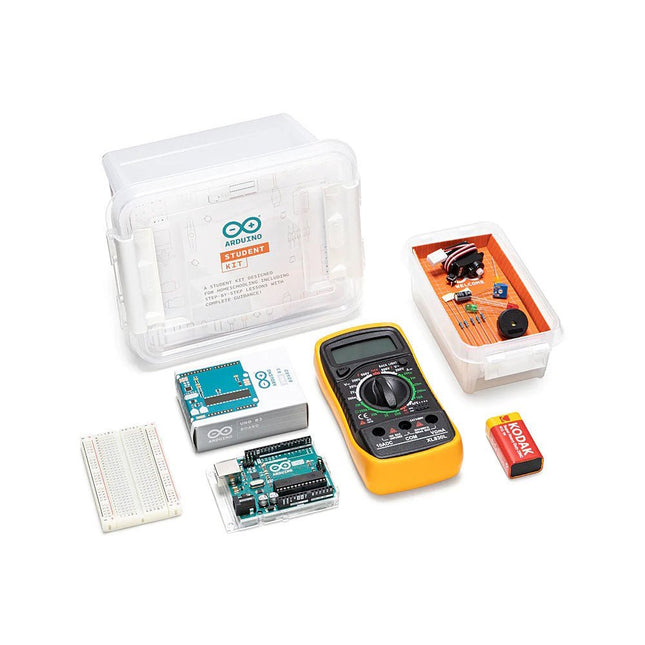
Arduino Arduino Student Kit
The Arduino Student Kit is a hands-on, step-by-step remote learning tool for ages 11+: get started with the basics of electronics, programming, and coding at home. No prior knowledge or experience is necessary as the kit guides you through step by step. Educators can teach their class remotely using the kits, and parents can use the kit as a homeschool tool for their child to learn at their own pace. Everyone will gain confidence in programming and electronics with guided lessons and open experimentation. Learn the basics of programming, coding and electronics including current, voltage, and digital logic. No prior knowledge or experience is necessary as the kit guides you through step by step. You’ll get all the hardware and software you need for one person, making it ideal to use for remote teaching, homeschooling, and for self-learning. There are step-by-step lessons, exercises, and for a complete and in-depth experience, there’s also extra content including invention spotlights, concepts, and interesting facts about electronics, technology, and programming. Lessons and projects can be paced according to individual abilities, allowing them to learn from home at their own level. The kit can also be integrated into different subjects such as physics, chemistry, and even history. In fact, there’s enough content for an entire semester. How educators can use the kit for remote teaching The online platform contains all the content you need to teach remotely: exclusive learning guidance content, tips for remote learning, nine 90-minute lessons, and two open-ended projects. Each lesson builds off the previous one, providing a further opportunity to apply the skills and concepts students have already learned. They also get a logbook to complete as they work through the lessons. The beginning of each lesson provides an overview, estimated completion times, and learning objectives. Throughout each lesson, there are tips and information that will help to make the learning experience easier. Key answers and extension ideas are also provided. How the kit helps parents homeschool their children This is your hands-on, step-by-step remote learning tool that will help your child learn the basics of programming, coding, and electronics at home. As a parent, you don’t need any prior knowledge or experience as you are guided through step-by-step. The kit is linked directly into the curriculum so you can be confident that your children are learning what they should be, and it provides the opportunity for them to become confident in programming and electronics. You’ll also be helping them learn vital skills such as critical thinking and problem-solving. Self-learning with the Arduino Student Kit Students can use this kit to teach themselves the basics of electronics, programming, and coding. As all the lessons follow step-by-step instructions, it’s easy for them to work their way through and learn on their own. They can work at their own pace, have fun with all the real-world projects, and increase their confidence as they go. They don’t need any previous knowledge as everything is clearly explained, coding is pre-written, and there’s a vocabulary of concepts to refer to. The Arduino Student Kit comes with several parts and components that will be used to build circuits while completing the lessons and projects throughout the course. Included in the kit Access code to exclusive online content including learning guidance notes, step-by-step lessons and extra materials such as resources, invention spotlights and a digital logbook with solutions. 1x Arduino Uno 1x USB cable 1x Board mounting base 1x Multimeter 1x 9 V battery snap 1x 9 V battery 20x LEDs (5x red, 5x green, 5x yellow & 5x blue ) 5x Resistors 560 Ω 5x Resistors 220 Ω 1x Breadboard 400 points 1x Resistor 1 kΩ 1x Resistor 10 kΩ 1x Small Servo motor 2x Potentiometers 10 kΩ 2x Knob potentiometers 2x Capacitors 100 uF Solid core jumper wires 5x Pushbuttons 1x Phototransistor 2x Resistors 4.7 kΩ 1x Jumper wire black 1x Jumper wire red 1x Temperature sensor 1x Piezo 1x Jumper wire female to male red 1x Jumper wire female to male black 3x Nuts and Bolts
€ 79,95€ 59,95
Members identical
-
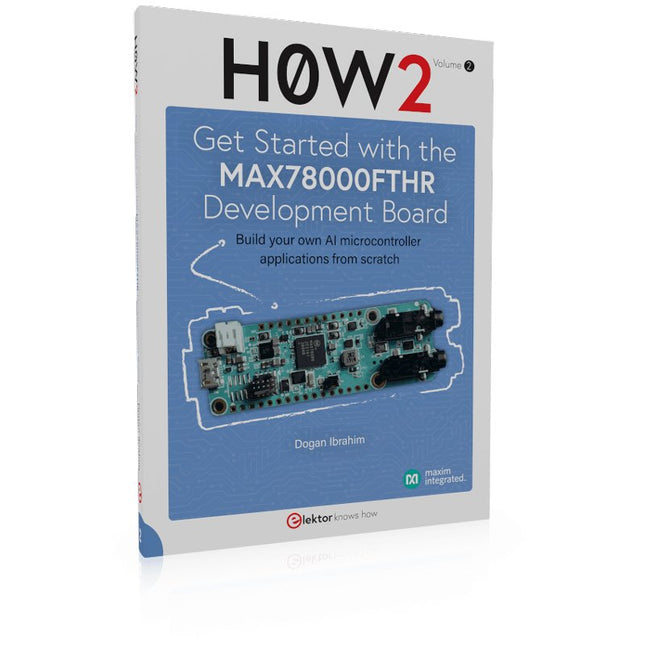
Elektor Publishing H0W2: Get Started with the MAX78000FTHR Development Board
Build your own AI microcontroller applications from scratch The MAX78000FTHR from Maxim Integrated is a small development board based on the MAX78000 MCU. The main usage of this board is in artificial intelligence applications (AI) which generally require large amounts of processing power and memory. It marries an Arm Cortex-M4 processor with a floating-point unit (FPU), convolutional neural network (CNN) accelerator, and RISC-V core into a single device. It is designed for ultra-low power consumption, making it ideal for many portable AI-based applications. This book is project-based and aims to teach the basic features of the MAX78000FTHR. It demonstrates how it can be used in various classical and AI-based projects. Each project is described in detail and complete program listings are provided. Readers should be able to use the projects as they are, or modify them to suit their applications. This book covers the following features of the MAX78000FTHR microcontroller development board: Onboard LEDs and buttons External LEDs and buttons Using analog-to-digital converters I²C projects SPI projects UART projects External interrupts and timer interrupts Using the onboard microphone Using the onboard camera Convolutional Neural Network
€ 39,95
Members € 35,96
-
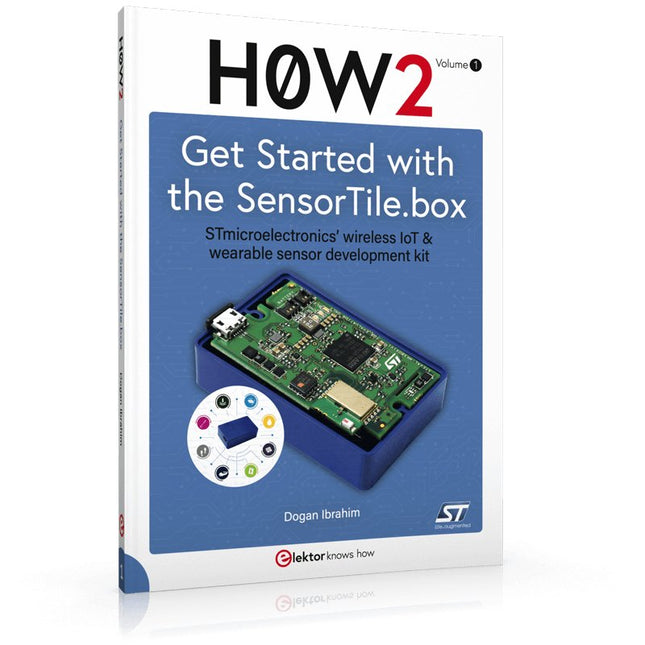
Elektor Publishing H0W2: Get Started with the SensorTile.box
STmicroelectronics’ wireless IoT & wearable sensor development kit ‘SensorTile.box’ is a portable multi-sensor circuit board housed in a plastic box and developed by STMicroelectronics. It is equipped with a high-performance 32-bit ARM Cortex-M4 processor with DSP and FPU, and various sensor modules, such as accelerometer, gyroscope, temperature sensor, humidity sensor, atmospheric pressure sensor, microphone, and so on. SensorTile.box is ready to use with wireless IoT and Bluetooth connectivity that can easily be used with an iOS or Android compatible smartphone, regardless of the level of expertise of the users. SensorTile.box is shipped with a long-life battery and all the user has to do is connect the battery to the circuit to start using the box. The SensorTile.box can be operated in three modes: Basic mode, Expert mode, and Pro mode. Basic mode is the easiest way of using the box since it is pre-loaded with demo apps and all the user has to do is choose the required apps and display or plot the measured data on a smartphone using an app called STE BLE Sensor. In Expert mode users can develop simple apps using a graphical wizard provided with the STE BLE Sensor. Pro mode is the most complex mode allowing users to develop programs and upload them to the SensorTile.box. This book is an introduction to the SensorTile.box and includes the following: Brief specifications of the SensorTile.box; description of how to install the STE BLE Sensor app on an iOS or Android compatible smartphone required to communicate with the box. Operation of the SensorTile.box in Basic mode is described in detail by going through all of the pre-loaded demo apps, explaining how to run these apps through a smartphone. An introduction to the Expert mode with many example apps developed and explained in detail enabling users to develop their own apps in this mode. Again, the STE BLE Sensor app is used on the smartphone to communicate with the SensorTile.box and to run the developed apps. The book then describes in detail how to upload the sensor data to the cloud. This is an important topic since it allows the sensor measurements to be accessed from anywhere with an Internet connection, at any time. Finally, Pro mode is described in detail where more experienced people can use the SensorTile.box to develop, debug, and test their own apps using the STM32 open development environment (STM32 ODE). The Chapter explains how to upload the developed firmware to the SensorTile.box using several methods. Additionally, the installation and use of the Unicleo-GUI package is described with reference to the SensorTile.box. This PC software package enables all of the SensorTile.box sensor measurements to be displayed or plotted in real time on the PC.
€ 34,95
Members € 31,46
-
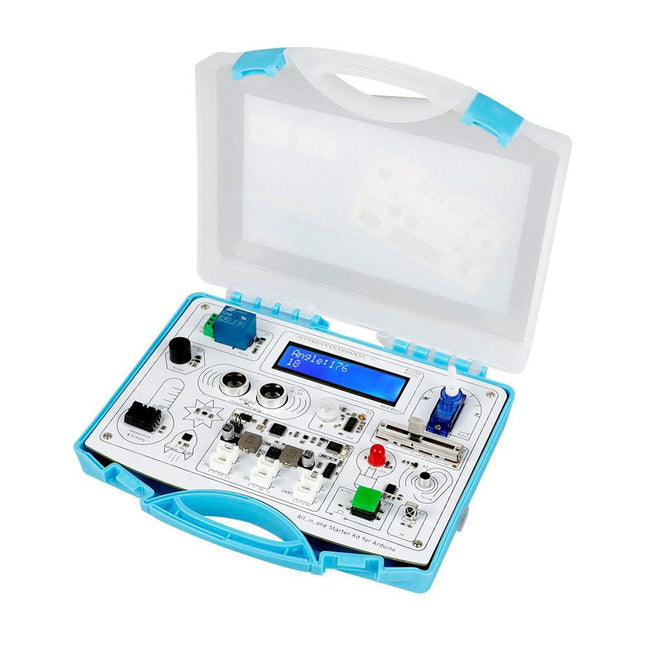
Elecrow Elecrow All-in-One Starter Kit for Arduino
15 Sensor Modules & 21 Tutorials The Elecrow All-in-One Starter Kit for Arduino is the perfect choice for beginners looking to explore the world of Arduino in a fun and accessible way. The kit includes more than 20 interactive tutorials, ranging from easy to advanced. These step-by-step guides help you master sensor usage, develop logical thinking skills, and spark your creativity. The kit contains 15 sensors in total: 14 built-in sensors and 1 humidity sensor with a Crowtail interface. Each sensor offers unique features and functions, making them ideal for Arduino novices. Additionally, the kit includes 6 Crowtail interfaces, enabling compatibility with over 150 types of Crowtail sensors and offering excellent expandability. These features make it a great entry-level tool for fostering logical thinking and innovation. Unlike most starter kits, this all-in-one kit uses a unified board design — no breadboard, no soldering, and no wiring required. This allows you to focus entirely on programming and learning Arduino. Features 15 sensors with different functions, 21 creative tutorials Common board design for sensors, no need to solder wires, direct use Portable suitcase (small and exquisite) Reserved 6 Crowtail interfaces (3x I/O, 2x I²C, 1x UART) Visualized silk screen printing, corresponding to the characteristics of each sensor Specifications All-in-one Starter Kit for Raspberry Pi Pico 2 All-in-one Starter Kit for Arduino Main Processor Raspberry Pi Pico 2 RP2350 ATmega328P Number of Sensors 17 sensors 15 sensors (including 1 Humidity sensor) Sensor Board Design Integrated sensor board, no soldering or complex wiring required Display 2.4-inch TFT full-color touch screen N/A Ambient Lights 20 full-color ambient lights, switchable via touch screen N/A Built-in Mini Games Yes No Expansion Interfaces N/A 6 Crowtail interfaces(3x I/O, 2x I²C, 1x UART) Programming Environment Based on Arduino software Number of Tutorials 21 creative tutorials Interface USB-C Dimensions 195 x 170 x 46 mm Weight 380 g 340 g Included 1x Elecrow All-in-One Starter Kit for Arduino 1x Moisture Sensor with Cable 1x IR Remote Control 1x USB-C Cable Downloads Datasheet Manual Wiki
€ 44,95€ 34,95
Members identical
-
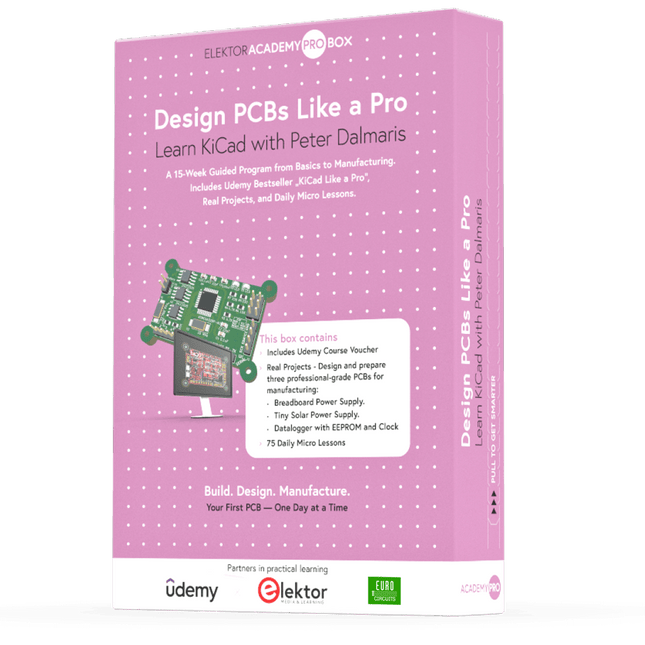
Elektor Academy Pro Design PCBs Like a Pro
Learn KiCad with Peter Dalmaris The Academy Pro Box "Design PCBs like a Pro" offers a complete, structured training programme in PCB design, combining online learning with practical application. Based on Peter Dalmaris’ KiCad course, the 15-week programme integrates video lessons, printed materials (2 books), and hands-on projects to ensure participants not only understand the theory but also develop the skills to apply it in practice. Unlike standard courses, the Academy Pro Box provides a guided learning path with weekly milestones and physical components to design, test, and produce working PCBs. This approach supports a deeper learning experience and better knowledge retention. The box is ideal for engineers, students, and professionals who want to develop practical PCB design expertise using open-source tools. With the added option to have their final project manufactured, participants complete the programme with real results – ready for use, testing, or further development. Learn by doing Build skills. Design real boards. Generate Gerbers. Place your first order. This isn’t just a course – it’s a complete project journey from idea to product. You’ll walk away with: Working knowledge of KiCad’s tools Confidence designing your own PCBs A fully manufacturable circuit board – made by you What's inside the Box (Course)? Both volumes of "KiCad Like a Pro" (valued at €105) Vol 1: Fundamentals and Projects Vol 2: Advanced Projects and Recipes Coupon code to join the bestselling KiCad 9 online course by Peter Dalmaris on Udemy, featuring 20+ hours of video training. You'll complete three full design projects: Breadboard Power Supply Tiny Solar Power Supply Datalogger with EEPROM and Clock Voucher from Eurocircuits for the production of PCBs (worth €85 excl. VAT) Learning Material (of this Box/Course) 15-Week Learning Program ▶ Click here to open Week 1: Setup, Fundamentals, and First Steps in PCB Design Week 2: Starting Your First PCB Project – Schematic Capture Week 3: PCB Layout – From Netlist to Board Design Week 4: Design Principles, Libraries, and Workflow Week 5: Your First Real-World PCB Project Week 6: Custom Libraries – Symbols, Footprints, and Workflow Week 7: Advanced Tools – Net Classes, Rules, Zones, Routing Week 8: Manufacturing Files, BOMs, and PCB Ordering Week 9: Advanced Finishing Techniques – Graphics, Refinement, and Production Quality Week 10: Tiny Solar Power Supply – From Schematic to Layout Week 11: Tiny Solar Power Supply – PCB Layout and Production Prep Week 12: ESP32 Clone Project – Schematic Design and Layout Prep Week 13: ESP32 Clone – PCB Layout and Manufacturing Prep Week 14: Final Improvements and Advanced Features Week 15: Productivity Tools, Simulation, and Automation KiCad Course with 18 Lessons on Udemy (by Peter Dalmaris) ▶ Click here to open Introduction Getting started with PCB design Getting started with KiCad Project: A hands-on tour of KiCad (Schematic Design) Project: A hands-on tour of KiCad (Layout) Design principles and PCB terms Design workflow and considerations Fundamental KiCad how-to: Symbols and Eeschema Fundamental KiCad how-to: Footprints and Pcbnew Project: Design a simple breadboard power supply PCB Project: Tiny Solar Power Supply Project: MCU datalogger with build-in 512K EEPROM and clock Recipes KiCad 9 new features and improvements Legacy (from previous versions of KiCad) KiCad 7 update (Legacy) (Legacy) Gettings started with KiCad Bonus lecture About the Author Dr. Peter Dalmaris, PhD is an educator, an electrical engineer and Maker. Creator of online video courses on DIY electronics and author of several technical books. As a Chief Tech Explorer since 2013 at Tech Explorations, the company he founded in Sydney, Australia, Peter's mission is to explore technology and help educate the world. What is Elektor Academy Pro? Elektor Academy Pro delivers specialized learning solutions designed for professionals, engineering teams, and technical experts in the electronics and embedded systems industry. It enables individuals and organizations to expand their practical knowledge, enhance their skills, and stay ahead of the curve through high-quality resources and hands-on training tools. From real-world projects and expert-led courses to in-depth technical insights, Elektor empowers engineers to tackle today’s electronics and embedded systems challenges. Our educational offerings include Academy Books, Pro Boxes, Webinars, Conferences, and industry-focused B2B magazines – all created with professional development in mind. Whether you're an engineer, R&D specialist, or technical decision-maker, Elektor Academy Pro bridges the gap between theory and practice, helping you master emerging technologies and drive innovation within your organization.
€ 199,95
Members € 179,96
-
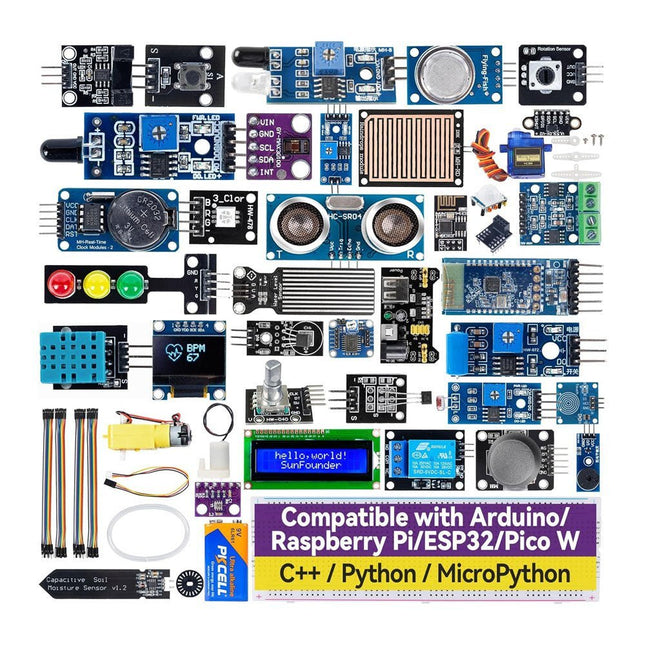
SunFounder Universal Maker Sensor Kit (for Raspberry Pi, Pico W, Arduino, ESP32)
Discover endless creativity with the Universal Maker Sensor Kit, designed for use with Raspberry Pi, Pico W, Arduino, and ESP32. This versatile kit offers compatibility across popular development platforms, including Arduino Uno R4 Minima/WiFi, Uno R3, Mega 2560, Raspberry Pi 5, 4, 3B+, 3B, Zero, Pico W, and ESP32. Featuring over 35 sensors, actuators, and displays, it's perfect for projects ranging from environmental monitoring and smart home automation to robotics and interactive gaming. Step-by-step tutorials in C/C++, Python, and MicroPython guide beginners and experienced makers alike through 169 exciting projects. Features Wide Compatibility: Fully supports Arduino (Uno R3, Uno R4 Minima/WiFi, Mega 2560), Raspberry Pi (5, 4, 3B+, 3B, Zero, Pico W), and ESP32, enabling extensive flexibility across numerous development platforms. Includes instructions for building 169 projects. Comprehensive Components: Features more than 35 sensors, actuators, and display modules suitable for diverse projects such as environmental monitoring, smart home automation, robotics, and interactive game controllers. Detailed Tutorials: Provides clear, step-by-step tutorials covering Arduino, Raspberry Pi, Pico W, ESP32, and each included component. Tutorials are available in C/C++, Python, and MicroPython, catering effectively to both beginners and experienced makers. Suitable for All Skill Levels: Offers structured projects designed to guide users seamlessly from beginner to advanced proficiency in electronics and programming, enhancing creativity and technical expertise. Included Breadboard Button Module Capacitive Soil Moisture Module Flame Sensor Module Gas/Smoke Sensor Module (MQ2) Gyroscope & Accelerometer Module (MPU6050) Hall Sensor Module Infrared Speed Sensor Module IR Obstacle Avoidance Sensor Module Joystick Module PCF8591 ADC DAC Converter Module Photoresistor Module PIR Motion Module (HC-SR501) Potentiometer Module Pulse Oximeter and Heart Rate Sensor Module (MAX30102) Raindrop Detection Module Real Time Clock Module (DS1302) Rotary Encoder Module Temperature Sensor Module (DS18B20) Temperature and Humidity Sensor Module (DHT11) Temperature, Humidity & Pressure Sensor (BMP280) Time of Flight Micro-LIDAR Distance Sensor (VL53L0X) Touch Sensor Module Ultrasonic Sensor Module (HC-SR04) Vibration Sensor Module (SW-420) Water Level Sensor Module I²C LCD 1602 OLED Display Module (SSD1306) RGB LED Module Traffic Light Module 5 V Relay Module Centrifugal Pump L9110 Motor Driver Module Passive Buzzer Module Servo Motor (SG90) TT Motor ESP8266 Module JDY-31 Bluetooth Module Power Supply Module Documentation Online Tutorial
€ 69,95
Members € 62,96
-
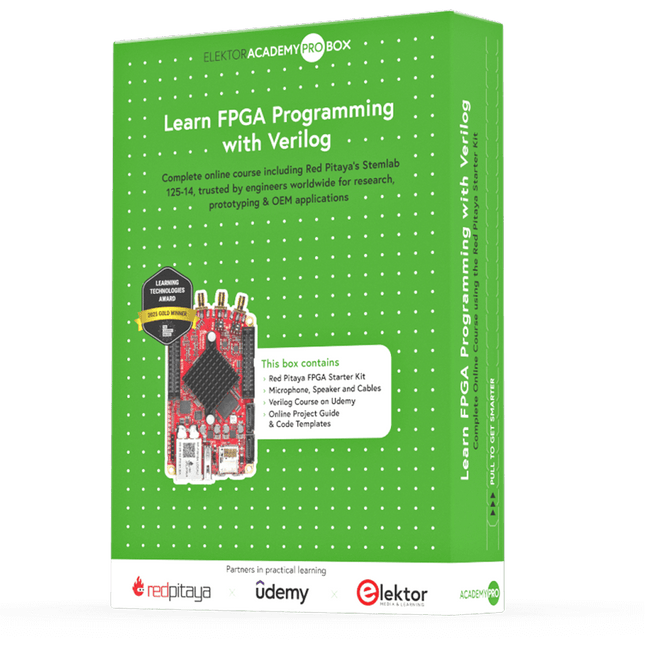
Elektor Academy Pro Learn FPGA Programming with Verilog
Master FPGA programming with the Red Pitaya Academy Pro Box. Learn Verilog and build a real-time audio processing system using Red Pitaya – with a full online course and hands-on project materials. The Academy Pro Box "Learn FPGA Programming with Verilog" is a complete learning solution for students, engineers and developers looking to gain hands-on experience with FPGA programming in Verilog. Combining theory with practice, the programme integrates a well-established Udemy course on Verilog fundamentals with nine exclusive practical modules developed by Elektor & Red Pitaya, designed specifically for the Red Pitaya STEMlab platform. Participants work with real hardware – delivered as part of the box – including the Red Pitaya STEMlab 125-14 Starter Kit and essential electronic components, enabling them to apply their knowledge immediately through real-world test setups. This combination of guided theory and structured experimentation ensures not only a strong understanding of FPGA principles, but also the ability to implement and verify designs independently. The box is aimed at professionals and advanced learners who want to go beyond simulation and gain practical skills in digital design. By the end of the programme, participants will have completed working FPGA projects, using industry-relevant tools and workflows – making this a valuable resource for academic & career development and technical innovation. What you’ll learn? Fundamentals of FPGA and Verilog Programming How to simulate, synthesize & implement digital circuits How to interface audio hardware with your FPGA Real-time Digital Signal Processing (DSP) techniques How to build, test, and customize audio filters Perfect for Professionals looking to level up their skills in Digital System Design Designers aiming to accelerate time-to-market for their applications Engineers pushing the boundaries of technological innovation Support when you need it In-depth troubleshooting in the course Community forums & Red Pitaya documentation Udemy Q&A and hardware support email What's inside the Box (Course)? Red Pitaya STEMlab 125-14 Starter Kit (valued at €550) 1x STEMlab 125-14 board 1x USB power supply (EU, UK & US) 1x microSD card (16 GB) with pre-installed OS 1x Ethernet cable Extra: 2x Oscilloscope Probes Extra: 2x SMA to BNC adapters Microphone & speaker set with cables Step-by-step project guide Downloadable code templates and schematics Lifetime access to a complete, self-paced Udemy course on Verilog Learning Material (of this Box/Course) 9 Practical Modules with Red Pitaya ▶ Click here to open Introduction Setting Up the Vivado Development Environment Project Setup & Vivado Integration Synthesis, Implementation & Bitstream Generation FPGA Image Overview First FPGA Projects – LEDs Full Audio Pass-Through Module 5 kHz Low-Pass Filter (4-Pole Cascade) Real-Time Microphone Input → Speaker Output Verilog Course with 28 Lessons on Udemy ▶ Click here to open Installing Vivado Vivado Design Flow Part 1 Vivado Design Flow Part 2 Commonly Asked Question’s from previous Module Fundamentals of Verilog Commonly Asked Question’s from previous Module Modeling Styles Assignment Operators in Verilog FAQ Behavioral Modeling Style Commonly Asked Question's from previous Module Gate Level Modeling Style Switch level Modeling Style Structural Modeling Style Schematic based Design Entry with IP integrator and Xilinx IP's Memories Commonly Asked Question's from previous Module Finite State Machines Commonly Asked Question's from previous Module Writing Testbenches Hardware Debugging with Vivado Required Hardware v File I/0 Projects RTL for Synthesis FPGA Architecture Fundamentals Commonly Asked Question's from previous Module Interview Preparations Next Step What is Elektor Academy Pro? Elektor Academy Pro delivers specialized learning solutions designed for professionals, engineering teams, and technical experts in the electronics and embedded systems industry. It enables individuals and organizations to expand their practical knowledge, enhance their skills, and stay ahead of the curve through high-quality resources and hands-on training tools. From real-world projects and expert-led courses to in-depth technical insights, Elektor empowers engineers to tackle today’s electronics and embedded systems challenges. Our educational offerings include Academy Books, Pro Boxes, Webinars, Conferences, and industry-focused B2B magazines – all created with professional development in mind. Whether you're an engineer, R&D specialist, or technical decision-maker, Elektor Academy Pro bridges the gap between theory and practice, helping you master emerging technologies and drive innovation within your organization.
€ 649,00
Members € 584,10








